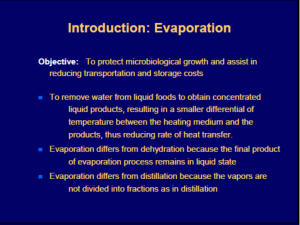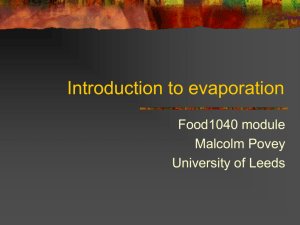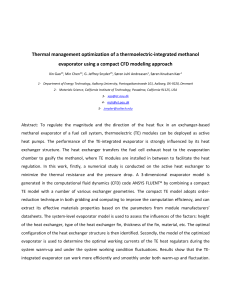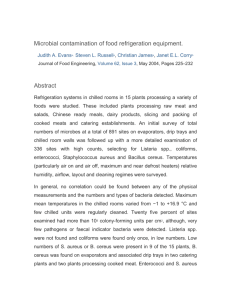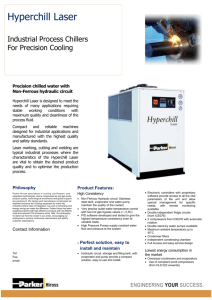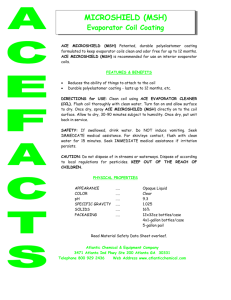Slayt 1
advertisement
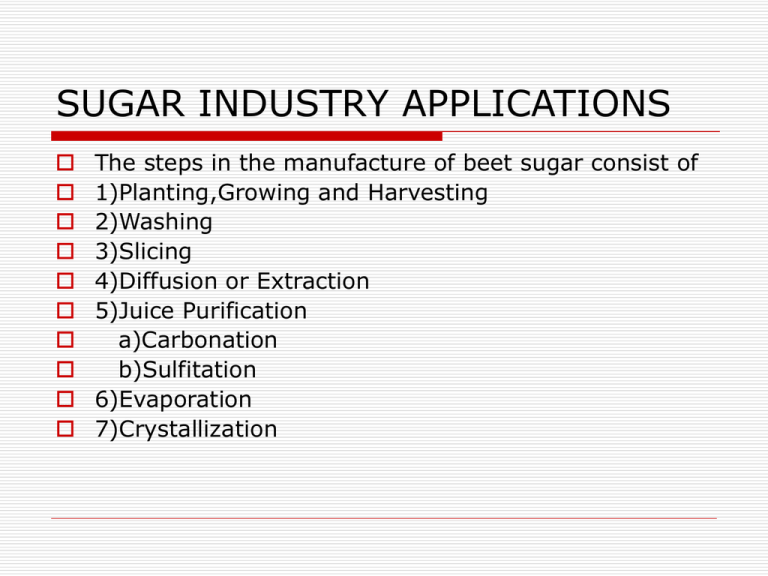
SUGAR INDUSTRY APPLICATIONS The steps in the manufacture of beet sugar consist of 1)Planting,Growing and Harvesting 2)Washing 3)Slicing 4)Diffusion or Extraction 5)Juice Purification a)Carbonation b)Sulfitation 6)Evaporation 7)Crystallization THE PRODUCTION PROCES The sugar beets are planted, they are grown and are harvested in SeptemberOctober. Sugar beets are washed and sliced into long,narrow strips called cossettes. DIFFUSION The cossettes go through a large tank called a diffuser where raw sugar juice is extracted.The cossettes are gently lifted from the bottom to the top of the diffuser as hot water washes over them absorbing the sugar.After the sugar-laden raw juice is drawn off, the beet pulp is left behind.And the pulp serves animal feeds. JUICE PURIFICATIONS Before crystallization it is necessary to remove impurities in raw juice.This is accomplished via carbonation.The main raw materials used in purification are lime and carbon dioxide gas.The resulting solution is called thin juice. EVAPORATION It is necessary to concentrate the purified juice.This is done by boiling of water from the solution in large vessel known as evaporator.On entering the evaporator, the solution contains approximately %14 sugar.On living the evaporators it contains in approximately %60. CRYSTALLIZATION In order to turn sugar into a crystalline form it is now necessary to evaporate still more water.This is done at a reduced temperature and pressure in vacuum pans.The crystals of sugar begin to form.The resulting sugar crystal and juice mix is called massecuite. CENTRIFUGALS The next step in the operation is to separete the sugar from the juice.This is done by centrifugals.In the centrifugals separator, the sugar is spun free of juice and after brief washing, is sent to drier and finally to cooler.The juice remaning after several crystallization called beet molasses.It is sold for cattle feed directly and also it can use for alcohol and ferment industry. EVAPORATORS Evaporators are used to separate the materials based on differences in their boiling temperature. There are ten types evaporator: 1)LONG TUBE VERTICAL 2)SHORT TUBE VERTICAL 3)FALLING FILM 4)RISING FILM 5)RISING/FALLING FILM 6)AGITATED THIN FILM 7)FORCED CIRCULATION 8)HORIZONTAL TUBE 9)SINGLE EFFECT 10)MULTIPLE EFFECT LONG TUBE VERTICAL The long tube vertical, evaporator is one of the most widely used tubular evaporators. It can be built as a large single unit, partially due to the high heat-transfer performance exhibited under most conditions, and partially because of the simplicity and low cost of construction. Feed flows upward through the tubes and heating medium flows downward on the shellside of a long-tube vertical evaporator. Some of the common uses of long-tube vertical evaporators are the concentration of cane sugar syrups, black liquor in paper plants, nitrates and electrolytic tinning liquors . SHORT TUBE VERTICAL EVAPORATOR The short-tube, or calandria, vertical evaporator is one of the earliest types still in widespread commercial use. Circulation and heat transfer in this type of evaporator are strongly affected by the liquid level. When this type of evaporator is used with a product that can deposit salt or scale, it is customary to operate with the liquid level appreciably higher than optimum and usually above the top tubesheet. However, heat transfer depends greatly on the effect of viscosity and temperature, it is not for use with temperature- sensetive materials, and it is unsuitable for crystalline products unless agitation is provided. In a short-tube vertical evaporator, the process liquid is inside the tubes and the heating medium outside the tubes. One principal use of the short-tube vertical evaporator is the concentration of sugar cane juice. FALLING FILM EVAPORATOR The long-tube falling-film evaporator is a variation of the long-tube vertical evaporator, in which the equipment is turned upside down so the tubular heat exchanger is on the top of the vapor/liquid separator section. The falling-film evaporator is particularly useful in applications where the temperature driving force between the heating medium and the liquid is small (less than 15 fahrenhyt). Typical applications for fallig-film evaporators are the concentration of dairy products (such as whey, milkprotein, skim milk, cream and hydrolyzed milk), sugarsolutions, urea, phosphoric acid and black liquor. RISING FILM EVAPORATOR Rising Film Evaporators The rising film evaporator provides a simple solution for concentration, volume reduction of liquids that have moderately heat sensitive products. Boiling in vertical tubes promotes vigorous circulation of remaining liquid. The liquid and vapor are separated in the cyclone separator. Multiple effect arrangement provides the steam economy. Concentration of dilute solutions containing water and organic solvents in applications such as Contaminated solvents recovery Waste water treatment Plant extracts in water or organic solvents As a reboiler to distillation column RISING/FALLING FILM EVAPORATOR The rising-film and the falling-film evaporators are sometimes combined into a rising/falling-film evaporator to incorporate the advantages of both. When a high ratio of evaporation to feed is required and the concentrate may be viscous, a tube bundle can be divided into two sections, with the first functioning as a rising- film evaporator and the second as a fallingfilm evaporator. They are best applied when handling clear fluids or foamy liquids, and when large evaporation loads are required. AGITATED THIN FILM EVAPORATOR One of the more useful types of evaporators for difficult to-handle materials is the agitated thin-film evaporator. Agitated thin-film evaporators have a wide processing flexibility, and a single system can often be designed to process different products under varied operating conditions. Normally, a thinfilm evaporator is operated under reduced pressures in the range of 2—250 mmHg abs. Agitated thin-film evaporators are typically used in such applications as: • purification of sensitive organic chemicals, such as natural oils, fatty acids, isocyanates, herbicides and insecticides • concentration of foods and pharmaceuticals, such as lecithin, enzymes, fruit and vegetable purees, biological solutions, vegetable and plant extracts, and fermentation broths • recovery of valuable resources from waste streams, such as solvents from paints, purification of used motor oil, glycerin from crude streams, and volume reduction of inorganic salt streams • devolatillization of thermoplastics, acrylic resins, phenolic resins, silicone polymers, polyester and naylon. FORCED CIRCULATION EVAPORATOR In most cases where the feed contains solids or crystallisation is present, forced circulation should be used. Typical applications where forced circulation should be used are sodium sulfate, urea, sodium chloride, ammonium sulfate, magnesium chloride, citric acid and caustic potash. HORIZONTAL EVAPORATOR The horizontal tube evaporator is the oldest type of chemical evaporator. The horizontal tube evaporator is the only type of chemical evaporator in which the heating medium is inside the tubes. The horizontal evaporator is least satisfactory for fluids that form scale or deposit salt (which would build up on the outside of the tube). it is well suited for processes where the final product is a liquid instead of a solid, such as sugar syrups where the large volume of liquid stored in the evaporator allows a close adjustment of the final density by changing the hold-up in the evaporator. SINGLE EFFECT EVAPORATOR Single-effect evaporators: A single-effect unit usually uses steam or high-temperature hot water to heat the process liquid to its boiling point. The steam is passed through a coil or jacket and the vapors produced by the boiling liquid are drawn off and condensed. The concentrated liquid then is pumped from the bottom of the vessel. In particular, singleeffect evaporators are utilized for small evaporation rates, or for liquids that boil at high temperatures (high boiling-point elevation liquors). MULTIPLE-EFFECT EVAPORATOR Multiple-effect evaporators: A multiple-effect unit consists of a series of single-effect evaporators. Vapor from the first evaporator is used as the heat source to boil liquid in the second evaporator. Boiling is accomplished by operating the second evaporator at a lower temperature than the first. The process can continue through evaporators (effects). Typical applications are caustic recovery plants in textile mills, sugar juice concentration, water recycling from distillery effluent, process evaporators, water recycling and zero liquid discharge plants for chemical, pharma, fertilizer, dye stuff, polymers, automobile, paint and other process industries.
